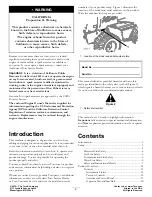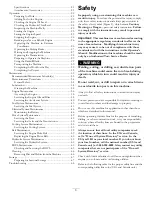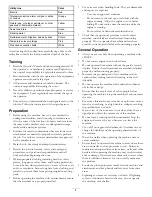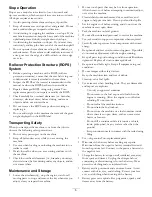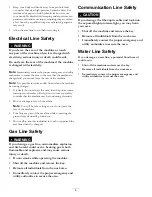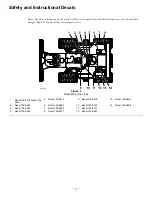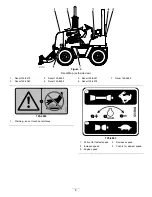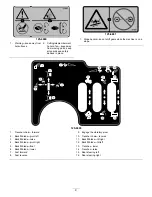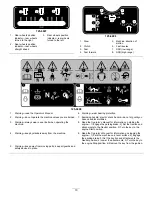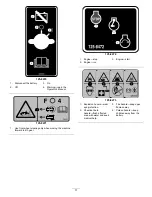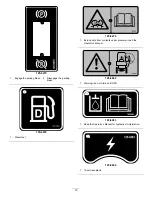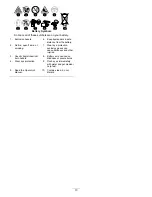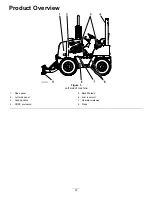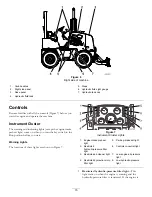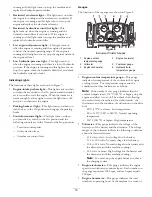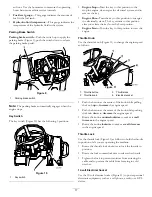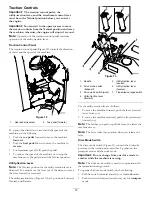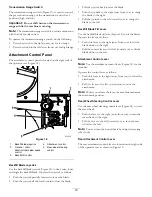
Utility Line
Color
Electric
Red
Telecommunication, alarm or signal, cables,
or conduit
Orange
Natural gas, oil, steam, petroleum, or other
gaseous or flammable material
Yellow
Sewer and drain
Green
Drinking water
Blue
Reclaimed water, irrigation, and slurry lines
Purple
Temporary survey markings
Pink
Proposed excavation limits
White
After locating all the utility lines, carefully dig a hole to the
utility line to verify the location and the depth of the line.
Training
•
Read the
Operator's Manual
and other training material. If
the operator(s) or mechanic(s) cannot read English, it is
the owner's responsibility to explain this material to them.
•
Become familiar with the safe operation of the equipment,
operator controls, and safety signs.
•
All operators and mechanics should be trained. The
owner is responsible for training the users.
•
Never let children or untrained people operate or service
the equipment. Local regulations may restrict the age of
the operator.
•
Ensure that you understand the hand signals used on the
job site. Follow the instructions of the signal person.
Preparation
•
Before using the machine, have the area marked for
underground utilities, and do not dig in marked areas.
Also, be aware of the location of objects and structures
that may not be marked, such as underground storage
tanks, wells, and septic systems.
•
Evaluate the terrain to determine what accessories and
attachments are needed to properly and safely perform
the job. Use only accessories and attachments approved
by the manufacturer.
•
Mark the job site clearly and keep bystanders away.
•
Review the job site hazards, safety and emergency
procedures, and personnel responsibilities with all
workers before beginning the work.
•
Wear appropriate clothing, including hard hat, safety
glasses, long pants, safety shoes, and hearing protection;
some jobs may also require that you wear a reflective vest
and/or a respirator. Secure long hair, loose clothing, and
jewelry to prevent them from getting tangled in moving
parts.
•
Before operating the machine with an attachment, ensure
that the attachment is properly installed.
•
Use extra care when handling fuels. They are flammable
and vapors are explosive.
–
Use only an approved container.
–
Do not remove the fuel cap or add fuel with the
engine running. Allow the engine to cool before
fueling. Do not smoke near the machine while the
engine is running.
–
Do not refuel or drain the machine indoors.
•
Check that the operator's presence controls, safety
switches, and shields are attached and functioning
properly. Do not operate the machine unless these
controls, switches, and shields are functioning properly.
General Operation
•
Always wear a seat belt when operating a machine with
a ROPS.
•
Do not run an engine in an enclosed area.
•
Do not operate the machine without the guards securely
in place. Ensure that all interlocks are attached, adjusted
properly, and functioning property.
•
Decrease the ground speed of the machine and use
caution when making turns and crossing roads and
sidewalks.
•
Do not operate the machine while under the influence
of alcohol or drugs.
•
Ensure that the area is clear of other people before
operating the machine. Stop the machine if anyone enters
the area.
•
Excessive vibration from a trencher or a plow can cause a
trench, an overhang, or a high bank to collapse, resulting
in possible injury or death.
•
If your view of the work area is not clear, always have a
signal person direct the movement of the machine.
•
Do not leave a running machine unattended. Stop the
engine and remove the key whenever you leave the
machine.
•
Use only Toro-approved attachments. Attachments can
change the stability and the operating characteristics of
the machine.
•
Watch for traffic when operating the machine near or
across roadways.
•
Ensure that you operate the machine in areas where there
are no obstacles in close proximity to you. Failure to
maintain an adequate distance from trees, walls, and other
barriers while operating the machine may result in injury
and/or damage. Operate the machine only in areas where
there is sufficient clearance for you to safely maneuver
the product.
•
Locate the pinch point areas marked on the machine and
attachments, and keep hands and feet away from these
areas.
•
Lightning can cause severe injury or death. If lightning
is seen or thunder is heard in the area, do not operate
the machine; seek shelter.
4
Содержание RT600
Страница 71: ...Notes 71...


